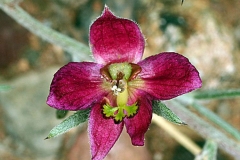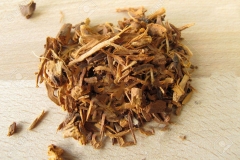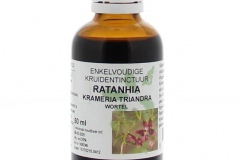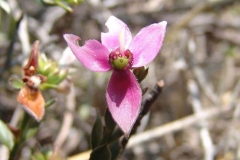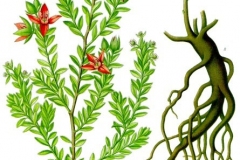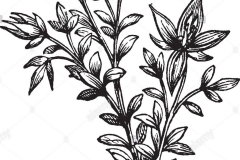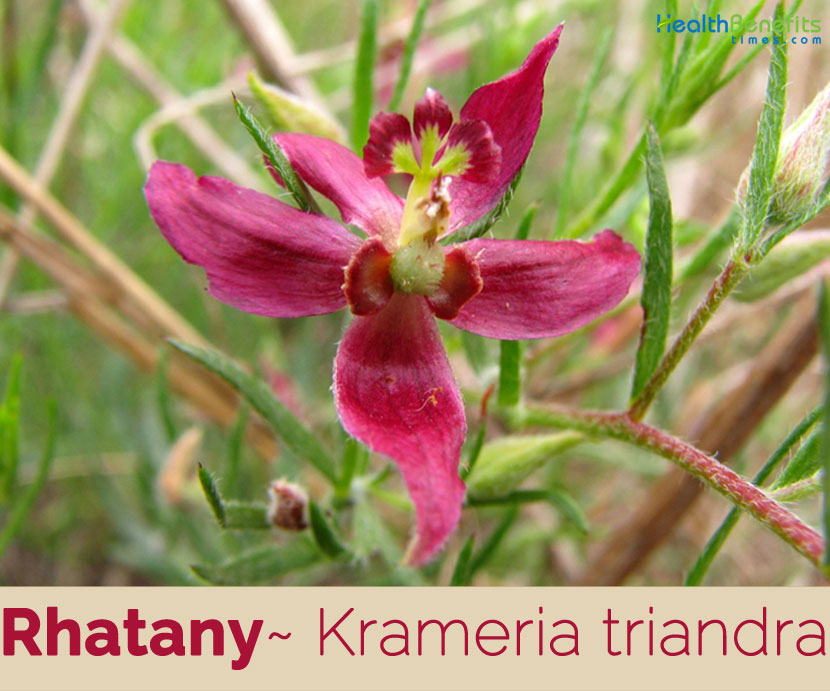 Krameria triandra, popularly known as rhatany is a genus of shrub belonging to Krameriaceae (Krameria family). The plant is native to found in the semi-desert regions of the South Americas, including Peru, Ecuador, Texas, Chile, Mexico, Bolivia, the West Indies, and northern Brazil. Since Ratanhia belongs to the family Krameriaceae it has several species within its genus, three of which are used in homeopathic remedies. Rhataniatannic acid, a natural astringent, can be extracted from the dried roots of Krameria argentea and Krameria lappacea, both referred to as para rhatany, and Krameria triandra, also called Peruvian ratanhia. Peruvian rhatany, rhatany-root, ratanhia, payta, krameria, mapato, Krameria root, Red Rhatany, Ratanya are some of the popular common names of the plant.
Krameria triandra, popularly known as rhatany is a genus of shrub belonging to Krameriaceae (Krameria family). The plant is native to found in the semi-desert regions of the South Americas, including Peru, Ecuador, Texas, Chile, Mexico, Bolivia, the West Indies, and northern Brazil. Since Ratanhia belongs to the family Krameriaceae it has several species within its genus, three of which are used in homeopathic remedies. Rhataniatannic acid, a natural astringent, can be extracted from the dried roots of Krameria argentea and Krameria lappacea, both referred to as para rhatany, and Krameria triandra, also called Peruvian ratanhia. Peruvian rhatany, rhatany-root, ratanhia, payta, krameria, mapato, Krameria root, Red Rhatany, Ratanya are some of the popular common names of the plant.
The name rhatany comes from the Peruvian Quechua language and means something like “plant that crawls over the ground” – an apt description of its growth pattern. The generic name Krameria is from the same source as the family name Krameriaceae. It was given to the plant by the Swedish botanist Pehr Löfling (1729-1756), a student of Carl von Linné (1707-1778), who named it in honor of Johann Georg Heinrich Kramer, a military physician in the Hungarian camp of Prince Eugene of Savoy (1663-1736). The scientific epithet ‘triandra’ is composed of the Latin tri = three and Greek Andros = man, and refers to the three male reproductive organs, the stamens, in the middle of the rhatany flower.
Rhatany Facts
| Name | Rhatany |
|---|---|
| Scientific Name | Krameria triandra |
| Native | South America, particularly Bolivia and Peru as well as dry areas over mountain slopes from Ecuador, Peru, Chile, and Bolivia to Argentina |
| Common Names | Peruvian rhatany, rhatany-root, ratanhia, payta, krameria, mapato, Krameria root, Red Rhatany, Ratanya |
| Name in Other Languages | Afrikaans: Rhatany Albanian: Rhatany Amharic: Rhatany Arabic: Rahani (رحاني), ratun eaqdi (رطن عقدي) Armenian: Rrat’ani (ռաթանի) Azerbaijani: Rhatany Bengali: Rhatany Bulgarian: Rhatany Burmese: R s (ရသ) Chinese: Lā dān ní (拉丹尼) Croatian: Rhatany Czech: Rhatany Danish: Ratanje Dutch: Rhatany English: Rhatany Esperanto: Rhatany Estonian: Rhatany Filipino: Rhatany Finnish: Rhatany, Punaratania French: Rhatany, Ratanhia Georgian: Rat’ania (რატანია) German: Rhatany, Ratanhia Greek: Ratány (Ρατάνυ) Gujarati: Raṭanī (રટની) Hausa: Rhatany Hebrew: Rhatany Hindi: Rhatany Hungarian: Rhatany Icelandic: Rhatany Indonesian: Ranyany Irish: Rhatany Italian: Ratania Japanese: Ratanī (ラタニー) Javanese: Rhatany Kannada: Ratāni (ರತಾನಿ) Kazakh: Ratani (ратани) Korean: Las tani (랏 타니) Kurdish: Rhatany Lao: Rhatany Latin: Rhatany Latvian: Rātānijs Lithuanian: Rhatany Macedonian: Ratanija (ратанија) Malagasy: Rhatany Malay: Rhatany Malayalam: Rāṟṟāni (റാറ്റാനി) Maltese: Rhatany Marathi: Rhatany Mongolian: Ratani (ратани) Nepali: Rhatany Norwegian: Ratania Oriya: Rhatany Pashto: Rhatany Persian: راتیانی Polish: Rhatany Portuguese: Rhatany, ratánia Punjabi: Rhatany Quechua: Pachalluq’i Romanian: Rhatany Serbian: Rtatani (ртатани) Sindhi: رهانٽي Sinhala: Ratani (රතනි) Slovenian: Rtatanija Spanish: Rhatany Sudanese: Rhatany Swedish: Rhatany Tajik: Ratana (Pатана) Tamil: Rattaṉi (ரத்தனி) Telugu: Rhatany Thai: Rhatany Turkish: Ozelliği Ukrainian: Rataniya (ратанія) Urdu: Rhatany Uzbek: Rhatany Vietnamese: Rhatany Welsh: Rhatany Zulu: Rhatany |
| Plant Growth Habit | Undemanding dense perennial, evergreen shrub |
| Growing Climates | Rocky and dry areas over mountain slopes, inter-Andean valleys and coastal hills |
| Plant Size | 3 ft (90 cm) tall |
| Root | Up to 50 cm long, cylindrical, flexible, reddish brown with dark scaly bark, astringent bark, wood almost tasteless |
| Branches | Low-lying branches are covered with silky down when they are young and then become woody and knotty as they age |
| Bark | Bark of the root is thin, readily separable, rough and scaly; of a dark, reddish-brown color outside, and bright brownish-red within |
| Leaf | Yellowish-white, downy, pointed, oblong-ovate leaves about one centimetre in length |
| Flower | Flowers, which grow from the leaf axils, have four petals which are red on the inside and have grey hairs on the outside. These petals frame three striking-looking stamens. The unusual thing about the flowers is that they do not produce nectar to attract insects. Instead they produce an odourless oil in special glands called elaiophores |
| Fruit Shape & Size | Fruit a one-celled globular drupe, covered with stiff, reddish hairs |
| Taste | Bitter, Astringent |
| Plant Parts Used | Dried root |
| Culinary Uses |
|
In its medicinal uses, Ratanhia can be drunk, gargled, or applied topically as a tincture or syrup to shrink tissues throughout the body. People may drink the tincture in order to constrict tissues to restrict the flow of blood or secretions of mucous. This can be useful for patients with diarrhea or peptic ulcers, though these patients may need additional medical care in some cases. It can also be gargled to help relieve sore throats by reducing mucous secretions. In its topical application, it is often used to stem bleeding in small wounds, such as a pulled tooth or a tear in the anus.
Plant Description
Rhatany is an undemanding dense perennial, evergreen shrub that normally grows about 3 ft. (90 cm) tall. The plant is found growing in rocky and dry areas over mountain slopes, inter-Andean valleys and coastal hills. Root is up to 50 cm long, cylindrical, flexible, reddish brown with dark scaly bark, astringent bark, wood almost tasteless. Bark of the root is thin, readily separable, rough and scaly; of a dark, reddish-brown color outside, and bright brownish-red within. It breaks with a slightly fibrous fracture, is tough and difficult to powder, and has a strong, purely astringent taste, tingeing the saliva red when chewed.
The central woody portion is very hard and almost tasteless. Neither bark nor wood has any marked odor. As the virtues of Rhatany reside in the bark, the smaller pieces are preferable. The roots are sold mostly in cylindrical pieces of different length and thickness. The roots or the root bark are used to make extracts and alcohol-based tinctures. Low-lying branches are covered with silky down when they are young and then become woody and knotty as they age. The plant has yellowish-white, downy, pointed, oblong-ovate leaves about one centimeter in length.
Flowers & Fruits
Flowers, which grow from the leaf axils, have four petals which are red on the inside and have grey hairs on the outside. These petals frame three striking-looking stamens. The unusual thing about the flowers is that they do not produce nectar to attract insects. Instead they produce odorless oil in special glands called elaiophores. Fertile flowers are followed by one-celled globular drupe, covered with stiff, reddish hairs.
Traditional uses and benefits of Rhatany
- Rhatany is useful in the treatment of inflammation of the mucous membranes of the mouth and throat and the gastrointestinal system, and for diarrhea.
- People take rhatany for intestinal swelling (enteritis) and chest pain (angina).
- Rhatany is occasionally used as a mouthwash or gargle for mild mouth and throat irritation, swollen gums, cracked tongue, and canker sores.
- It is also applied to the skin for leg ulcers and for swelling and itchiness caused by cold and damp weather (chilblains).
- In Peru the rhatany root has been known for its medicinal value for centuries.
- In traditional South American medicine, the herb was a widely used herbal remedy, especially for oral and dental hygiene.
- It has numerous useful applications when it comes to shrinking or constricting body tissues naturally.
- Herbal tea made from the root, at low doses, can be consumed in order to treat menorrhagia and for problems related to the gastrointestinal tract, such as diarrhea, dysentery, inflammation of the stomach and intestine (gastroenteritis), colitis and bleeding in the digestive tract.
- Compresses or ointments containing rhatany can be applied to minor wounds to halt bleeding, and as an herbal treatment for varicose veins and bruises.
- As a remedy for cuts, scrapes or sore nipples wet gauze can be used.
- For vaginal discharge, the herb has been used in the form of a decoction added to compresses, sitz baths or vaginal douching.
- For the treatment of hemorrhoids and anal fissures, a strong decoction of the herb can be used in sitz baths, ointments, or as rectal suppositories containing the powdered root.
- Rhatany root extract has been shown to have an antiviral effect on herpes simplex type I, and that it is active against certain bacteria such as Yersinia enterocolitica and Staphylococcus aureus.
- Rhatany is mostly used as an herbal remedy for ailments related to the mouth and throat.
- Diluted rhatany tincture is often used as a mouthwash or a gargle in the treatment of inflammation of the mucous membrane of the mouth, gingivitis, sore throat and inflammation of the tissue around the teeth.
- The herb is often added to special kinds of toothpaste that are used to reduce gum inflammation.
- As a remedy for gum inflammation, a concentrated rhatany tincture can also be brushed directly on the gums, or used in combination with tinctures made from other herbs with a good reputation as healing agents for mouth disorders, such as myrrh and sage.
- Inhale powdered rhatany root and blood root to cure nasal polyps.
- Root extract also tightens fine veins and tissues.
- Extract has strong antibacterial properties and can be used for the prevention and treatment of acne, etc.
- Rhatany also makes a good mouthwash and gargle for bleeding and infected gums, canker sores, and sore throats.
- Rhatany may also be applied to wounds to help staunch blood flow, to varicose veins, and over areas of capillary fragility that may be prone to easy bruising.
- It has been found useful for internal administration in chronic diarrhea, dysentery, and menorrhagia, incontinence of urine, hematuria, and passive hemorrhage from the bowels.
- In the form of an infusion it has been used locally in fissure of the anus, prolapsus ani, and leucorrhoea; as a gargle in relaxed, sore throat; and as an astringent wash for the mucous membrane of the eyes, nose, gums, etc.
Other Facts
- Root bark releases a red dye on boiling which can be used to color cotton and linen.
- It also imparts a red hue to lips, and in Portugal was formerly used to give color to port wine.
- It was a tradition among many women in the capital Lima to use the root to whiten their teeth during festivals and other major events.
Precautions
- It may cause allergic reactions.
- Rhatany can cause some side effects such as digestive complaints.
- Rarely, rhatany has caused allergic reactions in the linings of the mouth and throat.
- When the herb is used internally, it can cause minor discomfort and in very rare cases, allergic reactions in the mucous membranes.
- It is usually recommended that any internal application of the herb should be discontinued after a few days.
- Topical application of concentrated solutions like tinctures or fluid extracts can cause skin irritation in sensitive people.
References:
https://plants.usda.gov/core/profile?symbol=KRAME
https://gd.eppo.int/taxon/KRALP
https://botanical.com/botanical/mgmh/r/rhatan12.html


